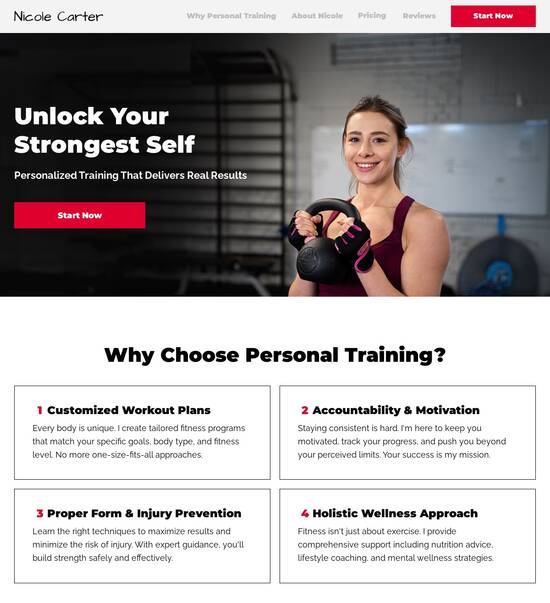
HTML page template for Shift managers
Use TemplateAbout template
Attract clients and showcase your skills with style using our landing page templates for Shift managers. Let's convert those visitors into clients!
Recommended templates

Easy to build without coding
With the intuitive drag-and-drop builder, anyone on your team can create high-converting pages without any knowledge of code or design. Make enhancements to your landing page with custom widgets using Javascript, HTML/CSS, or third-party scripts.

Multiple layouts for any industry and goal
Select from 500+ landing page layouts built to boost conversions across industry-specific scenarios. Customize them by adjusting fonts, adding images, and generating on-brand content with the AI assistant. Quickly scale with Instablocks® and Global Blocks that you can save, reuse, and update globally.

Loads fast and looks polished on any device
Every template is responsive, which means they present professionally on any device and load blazingly fast with our Thor Render Engine. You can also power them up with Google AMP technology to deliver an unparalleled mobile experience and drive higher conversions.

Robust analytics & experimentation
Get real-time updates and reporting across all your devices, showing the number of visitors, conversions, cost-per-visitor, and cost-per-lead. Launch AI-powered experiments, run A/B tests, and use heatmaps to analyze user behavior, then optimize your landing page to maximize conversions.







Easy to build without coding
With the intuitive drag-and-drop builder, anyone on your team can create high-converting pages without any knowledge of code or design. Make enhancements to your landing page with custom widgets using Javascript, HTML/CSS, or third-party scripts.
Multiple layouts for any industry and goal
Select from 500+ landing page layouts built to boost conversions across industry-specific scenarios. Customize them by adjusting fonts, adding images, and generating on-brand content with the AI assistant. Quickly scale with Instablocks® and Global Blocks that you can save, reuse, and update globally.
Loads fast and looks polished on any device
Every template is responsive, which means they present professionally on any device and load blazingly fast with our Thor Render Engine.
Robust analytics & experimentation
Get real-time updates and reporting across all your devices, showing the number of visitors, conversions, cost-per-visitor, and cost-per-lead. Launch AI-powered experiments, run A/B tests, and use heatmaps to analyze user behavior, then optimize your landing page to maximize conversions.
All the features you need to build lead-generating landing pages
Explore more featuresLearn how to build top-performing landing pages for any goal
FAQs
Leading the way in building high-performing landing pages





A comprehensive guide to optimizing landing pages with Instapage
Optimizing your marketing campaigns is crucial for achieving maximum ROI, and that's where Instapage’s powerful landing page and conversion rate optimization (CRO) platform shines. This guide will walk you through the steps to create high-performing landing pages tailored to your audience's needs, helping marketers from various sectors in the USA elevate their digital strategies.
Understanding the significance of landing pages
Landing pages serve as vital touchpoints in your marketing funnel. They are designed to convert visitors into leads or customers by capturing essential information. Using Instapage’s ready-to-use templates, businesses can quickly create pages without extensive coding knowledge, ensuring that even small marketing teams can effectively engage their audiences.
- High conversion rates: Instapage templates are designed focusing on conversion best practices, helping you maximize your marketing effectiveness.
- Time efficiency: No need for extensive coding or design skills; just select a template and start customizing.
- Flexibility: With over 100 layouts and dynamic text replacement, your landing pages can cater specifically to different audience segments.
Step 1: Selecting the right template
Choosing a high-converting template is the first step in your landing page creation. Instapage offers a library of over 100 tried-and-tested designs that focus on lead generation and conversion.
- Identify your goal: Choose templates that align with your specific campaign objectives, whether collecting emails or promoting a product.
- Consider your audience: Select designs that resonate with your target demographic across various verticals such as Tech/SaaS and Financial Services.
- Customization potential: Look for templates that offer rich customization options to ensure your page reflects your brand and message.
Step 2: Optimizing for conversions
Once you've selected a template, it’s time to focus on optimization strategies. Instapage facilitates A/B testing and offers heatmaps to analyze user behavior, enabling you to adjust your design for maximum engagement.
- A/B testing: Use this feature to experiment with different headlines, images, or call-to-actions, helping you discover what works best.
- Heatmaps: Track user clicks and interactions on your landing page to understand what grabs attention and what needs adjustment.
- Analytics dashboard: Stay informed about traffic, conversion rates, and lead generation metrics to continuously refine your strategy.
With these steps in mind, you're well on your way to creating high-converting landing pages that drive results for your marketing campaigns. The collaboration features of Instapage ensure that you can work efficiently with your team and stakeholders throughout the process.
In conclusion, leveraging an all-in-one platform like Instapage not only streamlines the landing page creation process but also empowers marketers to optimize their efforts, enhancing ROI from digital campaigns.
Ready to transform your marketing strategy? Start harnessing the power of Instapage to create amazing landing pages today!
People also ask about HTML page template for Shift managers
HTML page template for shift managers
Understanding the role of shift managers in modern workplaces
Shift managers play a crucial role in various industries by ensuring that operations run smoothly during designated hours. Their responsibilities encompass overseeing staff, managing schedules, and ensuring efficient communication among team members. Recognizing the complexities involved in supervising diverse groups of employees is essential for a shift manager to succeed.
Key responsibilities of shift managers include coordinating daily activities, resolving conflicts, and monitoring operational efficiency. Effective leadership and communication are vital attributes for shift managers. They act as a bridge between senior management and the workforce, facilitating feedback and fostering a positive work environment.
Oversee employee performance and ensure adherence to company policies.
Coordinate shift schedules and manage staffing levels.
Communicate with other departments to streamline operations.
The impact of shift managers on business operations is significant. They enhance efficiency in task management by ensuring that the right people are in the right roles at the right times. This not only boosts employee morale but also improves productivity across the board. The ability to coordinate effectively between various departments and teams allows shift managers to address issues swiftly, maintain workflow, and optimize resources.
Essential features of an HTML page template for shift managers
An HTML page template designed for shift managers should encompass a range of features to simplify their duties and improve operational oversight. One of the primary components is employee profiles management. A robust system allows for the creation and customization of profiles, where essential data such as names, contact details, and designations can be stored and organized efficiently.
To create a comprehensive employee profile management system, the template should include fields for skills, roles, and shift preferences. This helps shift managers make informed staffing decisions. Furthermore, organizing profiles effectively within the system enhances accessibility and promotes quick reference during busy shifts.
Field for employee identification such as name and employee ID.
Contact details like phone number and email address.
Position or role within the organization.
Additionally, attendance management features are critical for tracking employee presence and time-off requests. Effective tracking methodologies include biometric systems or mobile apps that allow employees to check in and out. The advantages of automated attendance systems lie in their efficiency and accuracy, saving valuable time for shift managers.
Navigating employee information and history
Maintaining a comprehensive employee information system is essential for a shift manager. Accurate records help ensure compliance with labor regulations and allow for better management of resources. Structuring data fields to include contact details, employment history, and training compliance ensure quick access to vital information when needed.
Additionally, tracking employee history involves documenting significant milestones like promotions and training completion. This historical data plays a vital role in performance evaluations, allowing managers to assess growth and set future goals. A centralized database enhances accessibility, making it easier for managers to retrieve information on their team at any time.
Documenting key employment milestones such as promotions.
Integrating historical data into annual performance reviews.
Analyzing employment trends to inform talent management strategies.
Implementing compensation and payroll processing features
An effective shift management HTML template should integrate a payroll processing feature. This is essential for ensuring that employees are compensated accurately and timely, directly influencing morale and productivity. A streamlined payroll system helps shift managers submit payroll with minimal errors, leading to fewer disputes and greater trust within the team.
Addressing common payroll challenges is vital. Shift managers can benefit from features that automate calculations and ensure compliance with labor regulations, which vary by location. A dedicated section for tracking compliance ensures that managers are equipped to handle audits and disputes effectively.
Integrated features for automated payroll calculations.
Documentation to ensure compliance with local labor laws.
A common interface for addressing payroll-related queries.
Enhancing team collaboration and communication
Effective team collaboration is essential for shift managers overseeing multiple shifts. Structuring teams based on roles and shifts promotes efficiency. Strategies such as establishing regular check-in meetings and using collaborative tools help maintain communication across shifts, reducing misunderstandings and enhancing team morale.
Utilizing a centralized communication platform is a game-changer for shift managers. Features that facilitate real-time updates can help eliminate communication silos, ensuring that all team members are on the same page. By providing a single point of access for sharing information and updates, productivity jumps significantly.
Tools enabling real-time communication and project management.
Methods to streamline updates and reduce miscommunication.
Benefits of consistent team-building activities to foster collaboration.
Leveraging talent management techniques
Identifying high-potential employees is crucial for the long-term success of any organization. Shift managers can employ methods to assess employee performance and potential through various metrics and feedback systems. By using data from performance evaluations and peer reviews, managers can recognize individuals who demonstrate leadership qualities.
Implementing regular feedback mechanisms allows managers to encourage growth among team members. These feedback loops can be structured through 360-degree reviews or targeted surveys. By fostering a culture of continuous improvement, organizations can tailor development plans that align with each employee's career aspirations.
Assessment tools for evaluating employee performance and growth potential.
Regular performance reviews to foster open communication.
Creating personalized development plans for career advancement.
Advanced features for optimizing shift management
Advanced functionalities for a shift manager's HTML page template include tools for analyzing attendance patterns. Understanding attendance data can guide resource allocation and shift scheduling. Shift managers can develop strategies to address absenteeism through targeted initiatives that improve engagement and satisfaction among employees.
Configuring shift patterns and assignments effectively is crucial for maintaining workflow consistency. Visual tools that display shifts can help managers see patterns at a glance, allowing for the identification of any inequities in work distribution. Flexible scheduling options can make it easier to accommodate employee preferences, leading to a more harmonious work environment.
Tools for visualizing attendance trends and scheduling needs.
Methods for considering employee preferences in scheduling.
Analyzing attendance data to identify patterns of absenteeism.
Real-world applications and benefits
Numerous organizations have successfully implemented technology-driven shift management strategies. Case studies highlighting these implementations reveal quantifiable outcomes such as improved attendance rates and increased employee satisfaction. Testimonials from employees provide insight into how these systems facilitate communication and streamline operations.
As technology evolves, so does shift management. Future trends indicate a focus on automation and artificial intelligence to bolster decision-making processes. These innovations promise significant enhancements in how organizations manage their workforce and respond to real-time challenges.
Organizations that have successfully employed technology for shift management.
Examples of quantitative improvements relating to productivity.
Employee feedback indicating the effectiveness of new systems.
Practical steps for adopting an HTML page template for shift managers
Before adopting a new HTML page template, evaluating your current shift management system is imperative. A self-assessment checklist can help identify gaps and inefficiencies, such as delayed responses to attendance requests or communication lapses. Setting achievable goals for improvement ensures that the transition to a new system is both effective and measurable.
Customizing the HTML template to meet organizational needs is also vital. Shift managers should consider features that align with departmental objectives while keeping user experience in mind. The template should be both functional and easy to navigate, encouraging adoption among staff.
Checklist for evaluating current shift management capabilities.
Tips for customizing the HTML template for specific organizational requirements.
Best practices for involving staff in the onboarding process of the new system.
Measuring the success of your shift management strategy
To gauge the effectiveness of a shift management strategy, tracking key performance indicators (KPIs) is essential. Common KPIs include attendance rates, employee satisfaction levels, and measures of productivity. By monitoring these metrics, shift managers can pinpoint areas that may require adjustments and implement corrective actions as needed.
Utilizing employee feedback reflects the state of workplace morale and can yield valuable insights. Regular evaluations of the system's performance also play a significant role in refining management approaches. It is crucial to maintain agility in strategies, allowing for quick adjustments that can lead to sustained improvement in overall team effectiveness.
Attendance and absenteeism rates as primary indicators of performance.
Employee satisfaction metrics gathered through surveys.
Measuring productivity impacts based on operational changes.
Ready to skyrocket conversions?
Supercharge your ad campaigns with high-performing landing pages
Get started














